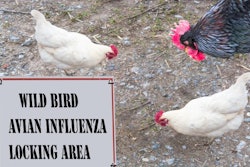
Recent mass mortality of seabirds off the coast of Western Cape have raised fears of a new wave of highly pathogenic avian influenza (HPAI) outbreaks in South Africa’s farmed poultry and ostriches. In West Africa, a previous outbreak series in Ivory Coast has ended, and there have been no new cases in Togo. Flock owners in Ghana who lost birds to the disease have been promised financial compensation.
Authorities in South Africa’s Western Cape report that there is a plan to deal with the latest suspected avian flu outbreak in wild birds.
Last week, The South African reported that more than 1,500 dead and dying seabirds have been found in the West Coast region. To tackle the issue, veterinarians collected the birds over the weekend in the districts of Bergrivier and Overberg. On-going tests will confirm whether the cause is avian flu.
With the clean-up continuing, a local official in Western Cape said that the number of dead birds collected has dropped from thousands to around 100.
In May of this year, the H5N1 HPAI virus was detected in South African wild and ornamental birds for the first time. Most recent cases were 10 seabirds that tested positive for this variant at three locations in Western Cape in mid-September.
Death toll among wild birds in the areas has recently been put at 1,500, reports Citizen. Worst affected have been an endangered species, the Cape cormorant. As birds are euthanized, their colony was rapidly depleting, according to the report.
Officials are warning the public to stay away from the area, and to report (and not handle) any sick or dead wild birds.
Latest report from TimesLive suggests there is yet no let-up in the losses of seabirds in Western Cape. Each day, an average of 700 pelicans, gulls and cormorants are found dead.
The same source reported previously that the H5N1 virus strain presents a low risk to human health.
There will likely be concern that this mass mortality of wild birds heralds the start of a new HPAI wave in domestic birds in South Africa.
South Africa reports 6 new HPAI outbreaks in domestic birds
Over the past three weeks, South Africa’s veterinary authority has officially recorded six new HPAI outbreaks in poultry and ostriches.
According to the latest official reports to the World Organisation for Animal Health (OIE), presence of the H5N1 HPAI virus variant was confirmed at three premises in Western Cape, and three more in KwaZulu-Natal.
Two of the outbreaks in Western Cape date back to July, and affected flocks of commercial ostriches. Also affected was a poultry farm with 14,800 birds in the West Coast region in the third week of September.
Between August 23 and September 18, three poultry flocks in KwaZulu-Natal tested positive for the same virus. Located in the uMgungundlovu municipality were two farms with 25,000 and an unspecified number of birds, and a backyard flock of 60 poultry.
Latest reports also refer to additional birds involved in and culled as a result of earlier HPAI outbreaks.
Since this outbreak series began in March of this year, the number of outbreaks registered with the OIE has reached 60. Also affecting flocks in the provinces of Eastern Cape, Free State, Gauteng, and North West, more than 3.37 million birds have been directly impacted by the disease in South Africa.
Avian flu resolved in Côte d’Ivoire
To the OIE, the veterinary authority in Côte d’Ivoire (Ivory Coast) has recently declared the HPAI situation closed.
Between mid-July and the end of August, three outbreaks occurred in this West African republic. First to be affected was a village flock in Mondoukou. This was followed one month later by further outbreaks in similar flocks in Mohamé and Modeste. All these villages are located in the same region of the country’s most southeasterly district, Comoé.
In total, more than 115,000 poultry were directly involved in these outbreaks, including around 48,500 mortalities.
To control the disease, authorities report that a total of almost 375,000 poultry were culled at 111 farms near the outbreaks. In addition, 186,000 hatching eggs and 8,000 table eggs were destroyed.
Ghana: poultry owners promised compensation
Earlier this month, Ghana Web reported that the agriculture ministry has announced plans to compensate poultry owners whose birds were culled to control HPAI. The minister has requested funding from the government to support the plan.
According to the Minister, Dr Owusu Afriyie Akoto, “serious efforts” are underway in the West African state to control avian flu.
No new outbreaks in Togo
Recent reports from the veterinary authority in the Togolese Republic to the OIE indicate there have been no new cases of HPAI in poultry.
Since June of this year, four outbreaks have been confirmed, all in the Maritime region in the south of the country. Presence of the H5N1 virus variant was confirmed at each location. Around 5,500 poultry were directly impacted in the outbreaks, the last of which began in mid-August.
View our continuing coverage of the global avian influenza situation.

















